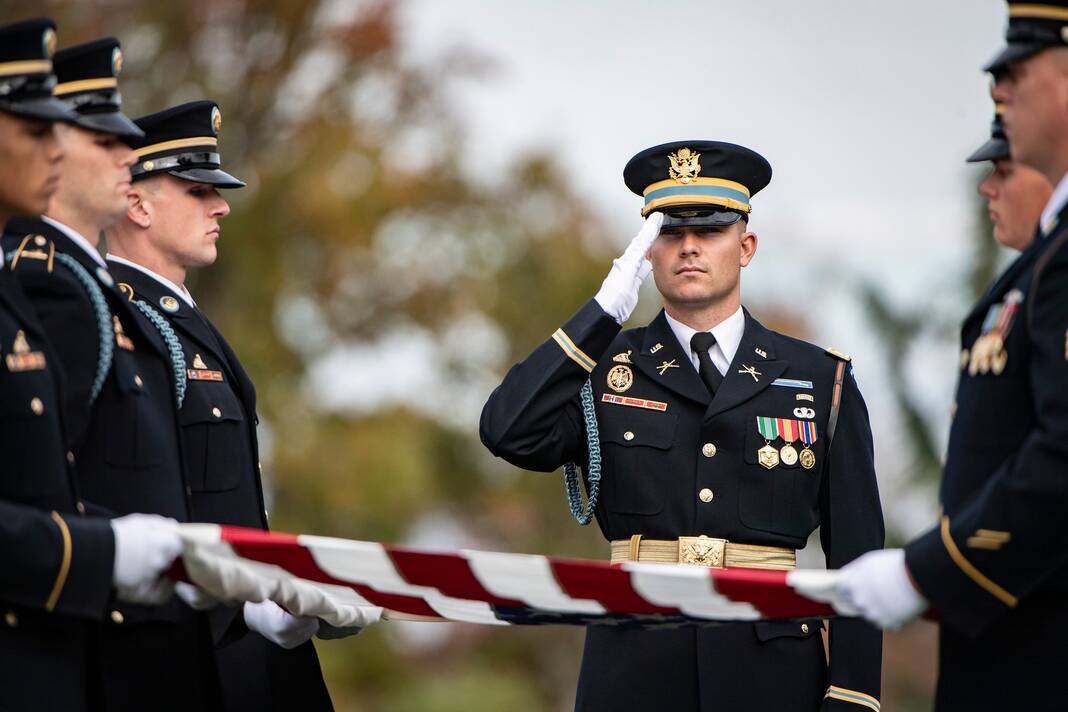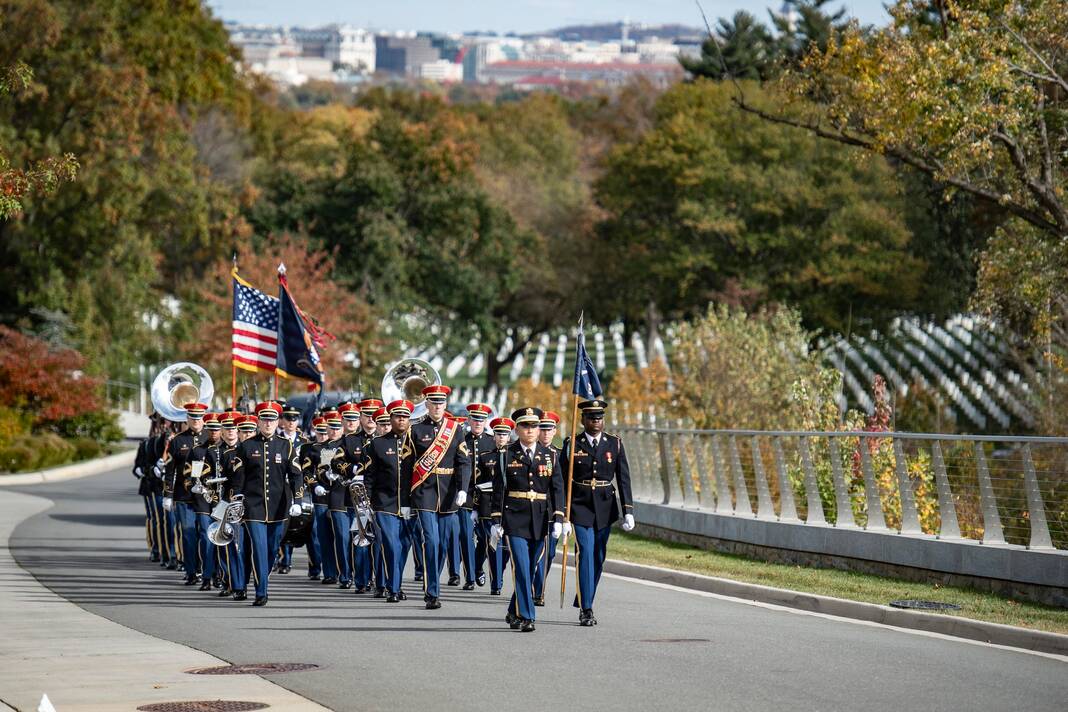|
Only have a minute? Listen instead
Getting your Trinity Audio player ready...
|
Porter Spencer sits stoically in his chair as a powerful Army officer in his perfect dress blues places a flag in the young boy’s hands.
Porter Spencer is 9 years old, and he carries the blood and the name of an aviator who died defending the United States and the world from atrocities unreal and unimaginable.
The legend of the boy’s great uncle, Porter Pile, has held a continuous presence in the Spencer household all of his life. A picture of the aviator who died in World War II has a prominent place in the Spencer home. Young Porter has grown up hearing the stories.
The young Porter now has a new story to tell, about the great uncle whose remains were finally found and identified and brought home. He has the story of attending his great uncle’s funeral at Arlington National Cemetery where the aviator was buried with full military honors.
Those honors included a 21-gun salute and a flyover by planes radically different from the B24 Liberator in which Pile was navigator before crashing near Kassel, Germany, in September of 1944.
“It felt really good,” said young Porter afterwards. “It felt important and special.”
This story began many years ago in a much younger Harlingen when Pile was a child Porter Spencer’s age attending local schools. He graduated from Harlingen High School in 1937, attended Texas A&I University in Kingsville, and then enlisted in the United States Army Air Corps in 1942.
He was trained as a navigator on a B24 bomber known as a “Liberator.” On his 23rd mission, he was part of a massive bombing campaign over Kassel, Germany, which had facilities for “tracked” vehicles used by Adolf Hitler’s Third Reich.
Several hundred bombers and fighter aircraft participated in the operation, but Pile’s group of about 35 planes got lost and most were shot down. One of them was Pile’s aircraft.
“It was an immense tragedy and remains the largest loss of aircraft in any one mission to this day for the United States Air Force,” said Randy Fleuriet, a nephew of Pile and the husband of long-time Harlingen school board member Gerry Fleuriet.

“The reports that later came back and based on interviews with other crewmembers, my Uncle Porter had been injured in the leg,” Fleuriet said. “He was close to a hatch to exit the aircraft which was on fire and there was another crewmember in the same vicinity. There was some kind of explosion, and the other crewmember was knocked out of the plane. He was able to open his parachute. He looked back up and he said he could not see the plane.”
And that’s where the story stopped, in that dim twilight place of not knowing, always wondering, forever hoping.
And then …
It’s 2017 and Pile’s family has never forgotten about its lost aviator, its lost hero, its lost uncle — and neither has the military.
“The Defense POW/MIA Accounting Agency contacted me to give them a DNA sample as well as my three cousins,” Fleuriet said. “We all gave DNA samples.”
OK and why would Pile’s relatives suddenly need to give DNA samples, unless …
The DPAA website says that in 2007, a German citizen led a team to the crash location of Pile’s airplane near the town of Richelsdorf, Germany. In 2009, another team located items at the site, including parachute fabric and other debris. Those discoveries led the team to recommend the site for excavation.
In 2015 and 2016, three recovery missions led by DPAA archeologists excavated the crash site and “recovered a data plate correlated to 2nd Lt. Pile’s airplane, an identification tag for another member of 2nd Lt. Pile’s crew and remains that have been identified as those of 2nd Lt. Pile.”
After the call in 2017, Fleuriet didn’t hear much about the case.
“They would contact me every couple of years and say they were still working but they didn’t have anything to report,” Fleuriet said. “And then on September 29, 2022 I got a call that they had positively identified the remains belonging to Porter Pile.”

It was the call for which everyone had waited, wondered and hoped. It was the call Pile’s parents, Leo and Helen, waited for and never received. It was the call Pile’s sisters, Rozanne and Virginia, desperately and painfully wanted — and never received.
But Pile’s relatives never forgot. His memory and the stories of his life always held a strong presence in the lives of his nieces and nephews. Fleuriet had always hoped his uncle would come home some day, and so had Fleuriet’s cousin Brett “Porter” Morgan who now carries his name as does his grandson young Porter Spencer who, as the youngest member of Pile’s family, received the flag from the sharp Army officer at Arlington National Cemetery. When the call came, there was relief, joy, celebration and pride.
“In January of this year we had a zoom meeting at my son’s house in Maryland where Gerry and I were,” Fleuriet said. “Of course, my cousin Brett Morgan lives in the Baltimore area, so he joined us. And there was a zoom meeting with the person who was in charge of the file in the DPAA.”
An Army officer was also physically present at the Maryland home and he brought with him some paperwork. For more than an hour, military officials gave the entire history of Pile’s case from the time his plane took off from England until the crash site was identified and excavated.
“At the conclusion of that they said the next thing would be to get a date scheduled at Arlington National Cemetery for the burial,” Fleuriet said.
Things began to move over the next few months. The funeral with full military honors was scheduled at Arlington National Cemetery for Oct. 31. This ceremony was poignant for many reasons, but it was unusual in that Porter’s fellow aviator Tech. Sgt. James Triplett was buried alongside him.
“I contacted my counterpart in the Triplett family, the oldest surviving member,” Fleuriet said. “He lived in Oregon, he was an attorney. I mentioned that since these two service members flew together, fought together and died together that it would be appropriate to have a joint service where they were both interred at the same time. He readily agreed to that.”
At the funeral, each family received a piece of the plane from the Kassel Mission Historical Society. Recall the Kassel operation lost an enormous number of aircraft and aviators. The organization serves to perpetuate and promote the memory and history of the Kassel Mission of Sept. 27, 1944.
“One of their members was a German who was very involved with this society,” Fleuriet said. “He had visited the crash site on numerous occasions and just picked up pieces that he could find. The Kassel Mission Historical Society presented us as well as the Triplett family with separate pieces of the aircraft. Mine was a control unit with wires.”
On that day, all the pieces came together. Two aviators from a very different war at a very different time finally received the honors due them. They might not have known the full story of what they were fighting for, but in the months after they fell from the sky, all the world knew what Pile and Triplett and all Allied forces had been fighting against as troops discovered the horrors of Auschwitz and Buchenwald and Dachau and … so many.

And they fought for many things, amongst them the chance for societies to rebuild their broken world and their cities and their sanity. They fought for the baby boom, for the 1955 Chevrolet Bel Air, for Mickey Mantle and the New York Yankees, for the music of Elvis Presley and Miles Davis and the Beach Boys and the Rolling Stones and The Beach Boys. They fought for Martin Luther King Jr. and the civil rights movement and Bobby Kennedy.
That’s what Porter Pile and James Triplett fought and died for, and that’s why their oldest and youngest relatives gathered at Arlington National Cemetery.
Everyone was moved, especially young Porter Spencer who received his great uncle’s flag.
“It was an incredible moment,” said his mother Rachel Spencer from her home in Roanoke, Virginia.
“I was so proud of him,” she said. “He’s heard the stories about his great Uncle Porter, he understood the significance of that day. But I think it was still probably overwhelming and he just stepped up and he knew what the moment meant. He knew what an honor that was. And to see my son as sitting next to my dad, both of whom share Porter’s name. For my son to receive the flag was just really incredible.”
It is also incredible, but not surprising, that the United States never forgets its fallen — nor do their families.
This is the final part of a three-part series on the life — and death — of Lt. Porter Pile.
Here’s the first and second parts:
Harlingen man missing for 80 years nearly finished required WWII combat runs




